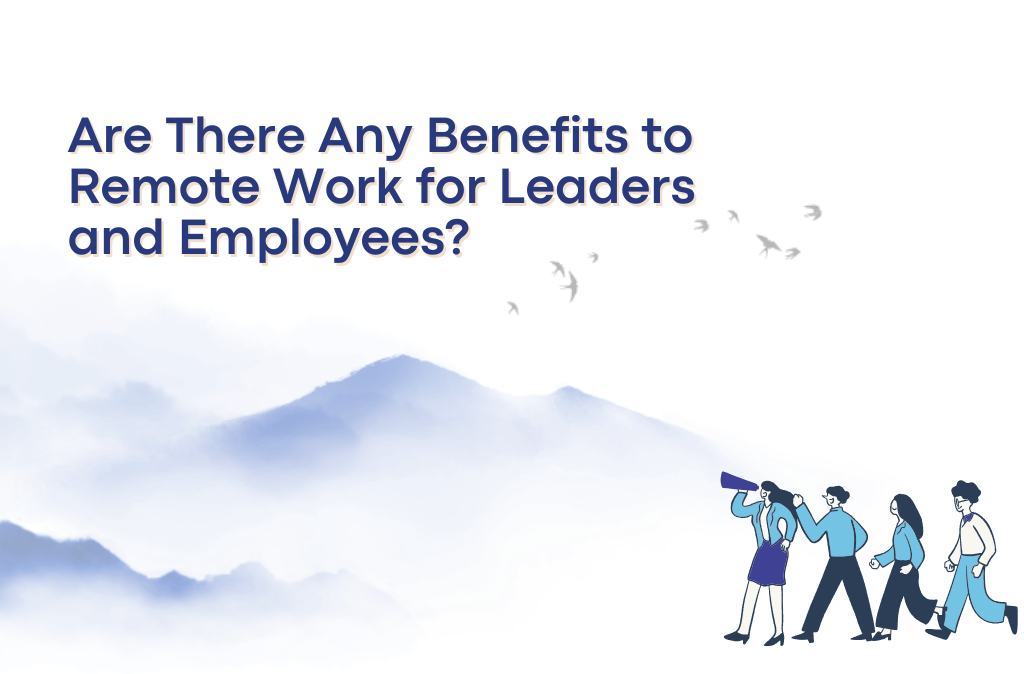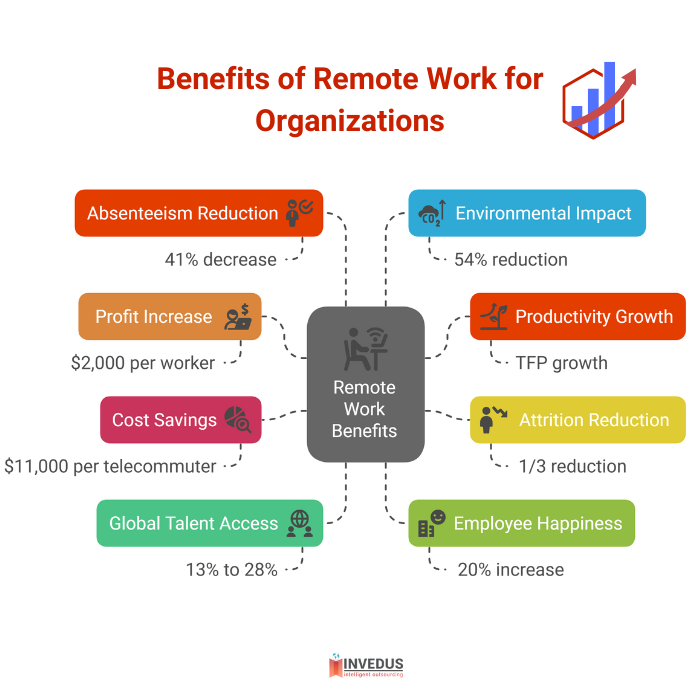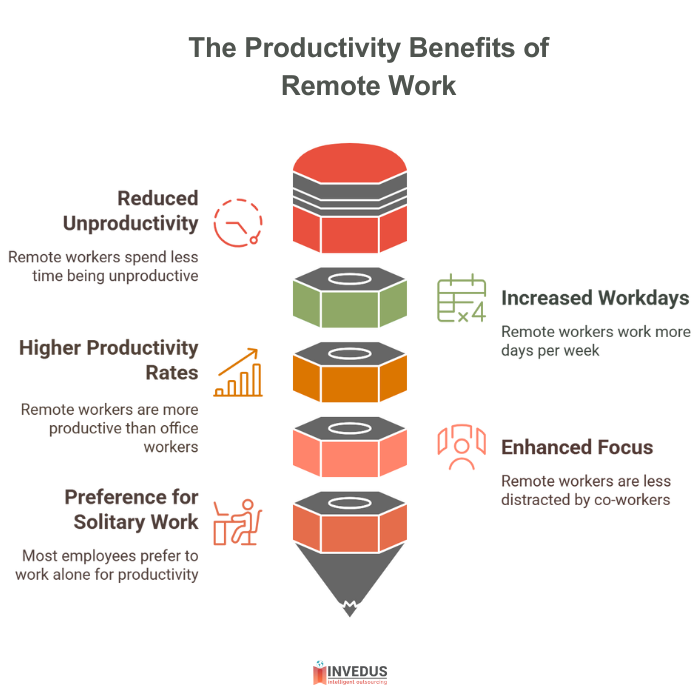Remote work has had a rich history, predating the Covid-19 pandemic. The early 2000s marked the beginning of widespread remote work with the adoption of broadband internet, laptops, and cell phones. Fast forward to 2020, and remote work statistics prove it is the only viable option.
According to a survey, 61% of business leaders believe remote work is here to stay for the long term, while 47% of company leaders allow employees to work from home full-time after the pandemic. The top companies in the market have understood the improvements in work efficiency and cost savings. So, the percentage of remote work is still going strong.
We have gathered 60+ remote work statistics and hybrid trends that can help you as a leader understand the importance of work from home, as an employee know the benefits, and as a general public know where the market is shifting.
General Statistics on Work from Home/Remote Work
Here are some common statistics you will find about remote work during your research as well:
- As of 2024, 20% of the U.S. workforce works from home, reflecting a significant shift in work practices.
- The percentage of remote workers increased dramatically across all major industries between 2019 and 2021, with some industries seeing over 39% of their workforce working remotely.
- 41% of employees work remotely on a hybrid basis, combining both home and office work.
- Telework rates vary across demographics, with higher rates among women and certain ethnic groups, such as Asians at 31.2%.
- Women are 26% more likely than men to apply for remote jobs, indicating a stronger preference for remote work among women.
- In FY 2023, 43% of federal employees participated in telework, highlighting its prevalence in government sectors.
- 38% of men work remotely full-time, compared to 30% of women, while 23% of men and 22% of women work part-time remotely.
Has Perspective on Remote Work Changed?
In short, yes. According to a survey by Owl Labs done in 2024, 31% of workers stated that if their employers threatened to eliminate remote work, they would start looking for new jobs, while 6% said they would quit outright.
That’s 1 in every 3 workers who are not comfortable with full-time office jobs. Mckinsey and Company also conducted their own research in which 52% of employees said they would prefer a hybrid working model, and 11% would prefer a fully remote model after the pandemic. As we live in the times after the pandemic, it is quite clear that people still prefer the comfort of their homes.
According to a Forbes article, the perspective on remote work became very clear. The data suggested that the age group of 24 to 35 is more likely to work remotely, with 39% doing so full-time and 25% practicing work from home part-time.
A recent 2024 Owl Labs US Workers Pulse survey revealed that 41% of employees say they are uncertain about the policies of where and when to work and that they are not applied equally throughout the organization.
By August 2023, The BLS (Bureau of Labor Statistics) reported that 19.5% of U.S. workers telework, reflecting a sustained shift post-pandemic. Let’s see some more relevant statistics that suggest the perspective shift on remote work:
- Remote work eligibility in the U.S. federal government rose from 52% in FY 2022 to 57% in FY 2023.
- Fully in-office job postings declined from 83% to 66% during 2023, indicating a broader shift towards flexible work arrangements.
- The U.S. federal government reported that 43% of its employees participated in telework in FY 2023.
- Surveys show that 91% of the workforce now expects remote work options, reflecting a change in societal expectations.
- Work from home rates vary across demographics, with higher rates among women (21.6%) and certain ethnic groups (e.g., Asians at 31.2%).
Are There Any Benefits to Remote Work for Leaders and Employees?

There are a lot of benefits for employers and employees to practice work from home. According to Everhour, leaders save around $44 billion annually by offering workplace flexibility to part-time workers, with potential savings of $11,000 per employee.
The U.S. Career Institute also states that fully remote employees save up to $12,000 annually by avoiding costs like commuting, office attire, and lunches, making remote work profitable for both.
Here are some more benefits that employees and employers get:
For Industry Leaders & Companies

There are indispensable benefits of remote work that leaders, CFOs, CEOs, and other top ranking officials get. According to a recent reports, here are some noteworthy benefits leaders have experienced with remote work:
- Remote work leads to an average profit increase of $2,000 per remote worker for companies.
- The U.S. Bureau of Labor Statistics found a positive correlation between TFP (Total Factor Productivity) growth over both the 2019–21 and the 2019–22 periods across 61 industries in the private business sector.
- Compared to traditional office settings, the hybrid work model has shown a 1/3 reduction in attrition rates, as proven by a Nature study.
- According to a FlexJobs and Global Workplace Analytics report, employers can save an average of $11,000 per half-time telecommuter annually due to increased productivity, lower real estate costs, and reduced absenteeism.
- According to Statista, the percentage in remote work of the global force increased from 13% in 2020 to 28% in 2023, helping companies secure global talent in remote work setting more easily.
- A report by Forbes delved deep into work from home employees who were 100% of the time were 20% happier on average compared to those who weren’t. This increase in satisfaction is important for better retention.
- Cited by Psicosmart, organizations that support remote work to help with work-life balance can experience a 41% decrease in absenteeism among their employees.
- A study published in Proceedings of National Academy of Sciences suggested that remote work employees reduce their emissions and carbon footprint by 54%.
For Employees
Employees benefit a lot from work from-home, remote work, and flexible timings. Especially when you take into consideration that the employees health is a priority is business expansion and other benefits, here is what remote work can do for the well-being of employes:
- According to Buffer, approximately 9 in 10 people surveyed have a positive experience doing remote work while 8% had a neutral experience and 1% had a somewhat negative experience.
- In the same Buffer study, 67% of people expressed their top benefit of remote work is flexible scheduling. While 62% preferred the choice of work location, 59% chose time saved on commute, 55% chose flexibility to live, and 48% said the financial savings mattered most.
- The IBM Institute for Business Value also conducted their own study to conclude that around every 3 in 5 CEOs believe in empowering remote work and making it a part of their business strategy.
- The DistantJob website discloses that remote workers save approximately $7,000 annually in commute costs, food expenses, and childcare.
- Surveyed by FlexJobs 33% of employees believe they have improved their mental health with the help of the flexibility of remote work.
- Citing Biteable, they surveyed 400 individuals to understand their perspective of remote work, reaching the conclusion that 63% of people experienced being more productive.
- The same Biteable blog suggests that employees don’t skimp on work hours when remote working. About 29% of employees spend 7 to 8 hours working, taking less than half an hour worth of breaks.
Is Full-Time Remote Work Better or Hybrid Work?
Certain statistics have shown that the attitude towards full-time remote work may not be what you think. According to research, 54% of people want to work fully remotely, though this preference is not as widespread as hybrid work – 83% of the global workforce considers hybrid work ideal.
This may be because of many reasons, like preference in flexibility, comfortness in environments, and more. Though, the statistics point to a direction where certain industries may favor remote work more than hybrid.
According to the U.S. Bureau of Labor Statistics, the top 4 industries of professional, scientific, and technical services; information; finance and insurance; and management of companies and enterprises had over 39% of their workforce working remotely (compared to less than 17% in 2019). In 2022, these 4 industries still had 46% of their workforce working remote. BLS data also shows that 10% of workers are full-remote, while 9.8% are hybrid, indicating a slight preference for full-remote in some contexts.
These trends can provide people with a good idea on whether hybrid or remote work are here to stay.
Is There a Productivity Increase in Remote Work?

Other than the fact that 62% of workers feel more productive (by Virtual Vocations) when working remotely, there are more statistics and studies that suggest remote work is a great way to enhance productivity and tap into unbelievable potential. According to a detailed study by Apollo Technical, productivity statistics like the following can be expected:
- On average, those who work from home spend 10 minutes less a day being unproductive.
- Remote workers work one more day a week compared to office workers.
- These same remote workers are up to 47% more productive than office workers, according to Stanford.
- A Stanford study of 16,000 workers over 9 months found that working from home increased productivity by 13%.
- 77% of those who work remotely at least a few times per month show increased productivity, Forbes report. Also, 30% do more work in less time and 24% do more work in the same period of time.
- A Great Place to Work study of 800,000 employees found remote work productivity was stable or increased when working remotely from home.
- Work from home employees spent 1.4 more days working each month, according to Airtasker survey.
- Workers in a home environment report they are less distracted by co-workers, spending 30 minutes less talking about non-work topics.
- Home workers spend 7% less time talking to management.
- A study conducted by Ask.com found that 86% of employees prefer to work by themselves when they are trying to be as productive as possible.

What Does Data Suggest About the Future of Remote Work?
Data across various studies highlights workers’ reluctance to return to traditional office settings. Nearly half of employees in one survey said they would quit if required to work full-time in the office. Another survey of over 8,400 U.S. workers revealed that 17% would take a 20% pay cut to work remotely, with 10% willing to sacrifice even more, despite the cost of living crisis.
Looking ahead, 32.6 million Americans are projected to work remotely by 2025, reflecting ongoing growth. The remote workplace services market is also set to expand from $20.1 billion in 2022 to $58.5 billion by 2027. Additionally, the percentage of fully remote jobs grew from 10% in Q1 2023 to 15% by Q4 2024, signaling a clear upward trend.
If you still have doubts about the future of remote work, it’s worth noting that digital remote positions are expected to reach 90 million globally by 2030, up from 73 million in 2024, according to another study.
Common Challenges of Remote Work
Remote work is not all fine and dandy. There are some challenges that are experienced by remote work employees only. We did our research to find some statistics that suggest and address the common challenges of remote work:
- 75% of people spend time on non-work activities like social media (75%), shopping online (70%), watching shows or movies (53%), and planning trips (32%) while working remotely, according to a Forbes report.
- A small study conducted found that 22% of professionals feel isolated when working remotely, and 32% face non-work distractions.
- A detailed Remote Co Survey discovered that up to 40% workers have a hard time unplugging from work. It indicated that due to the merge of their work and home environment, it becomes difficult to disassociate from work responsibilities.
- Also, data suggests that 36% of companies struggle with tracking productivity in remote settings.
- Also, a study by the University of Maryland found out that 40% of fully remote workers and 38% of hybrid workers experience increased anxiety and depression symptoms compared to in-person workers.
Oyster HR conducted a dedicated study that uncovered some disturbing statistics:
- Remote staff that work from home face less frequency of promotions than hybrid or on-site peers by up to 31%.
- While there is no data on how less remote work pays in comparison to on-site jobs, hybrid roles pay $22,000 less per year than in-office roles.
- The job security is also quite questionable in remote and hybrid roles. Fully remote workers are 35% more likely to be impacted by layoffs compared to hybrid or on-site peers.
These are some statistics that are very important to take into consideration if you are planning to completely switch to a remote work model. Be sure that you always weigh out the benefits and challenges to understand things better.
Is Remote Work Going To End Soon?

According to the trends we mentioned above, it seems like remote work is going to consume a big chunk of the market in the future. 59% of workers would choose an employer offering remote work options over one that doesn’t, indicating a strong preference for flexibility.
According to Strong DM, 15% of U.S. jobs are now remote, up from around 4% before the pandemic, indicating a significant and sustained increase in remote work opportunities.
About 83% of CEOs expect full-time office returns within three years, but 75% of companies struggle to enforce RTO mandates due to employee pushback. This further solidifies that remote work will be a trend for years to come.
Studies like that from Stanford have made it very clear that resignations at a company dropped by up to 50% when employees were allowed to work from home. This paints a very clear image, that people would love remote work rather than have a job.
Conclusion: Is Remote Work What People Want?
The above statistics are enough to prove whether remote work will stay or not. According to the 60+ statistics for remote work we covered, it is obvious that people want to continue their work from home routine.
Comfort isn’t the only reason, but the fact that remote work is flexible is the best part of the option. But, for people to transition from full-time positions to remote ones, businesses and employers will have to step up and explore the major benefits.
If remote and hybrid work is what people want, then businesses should begin offering the tools and support to help them succeed. This gradual shift will lead to better outcomes in the near future.
FAQs Related to Remote Work
Q1. Is remote work becoming more popular in 2025?
Yes, remote work continues to grow in popularity. The number of remote jobs has increased significantly since 2020, and many companies are adopting hybrid models to accommodate employee preferences for flexibility.
Q2. What percentage of employees prefer hybrid work arrangements?
A significant majority, about 83% of the global workforce, considers hybrid work ideal. This preference reflects a desire for flexibility and balance between remote and in-office work.
Q3. How does remote work impact productivity?
Studies show mixed results, but many employees report increased productivity when working remotely. Factors such as reduced commuting time and fewer office distractions contribute to this increase.
Q4. Are companies still hiring remote workers in 2025?
Yes, companies continue to hire remote workers. In fact, remote jobs now make up over 15% of total job opportunities in the U.S., indicating a sustained demand for remote talent.
Q5. What are the environmental benefits of remote work?
Remote work contributes to environmental sustainability by reducing commuting-related emissions. Full-time remote workers can cut emissions by up to 54% compared to their office-based peers, contributing to a cleaner environment.







